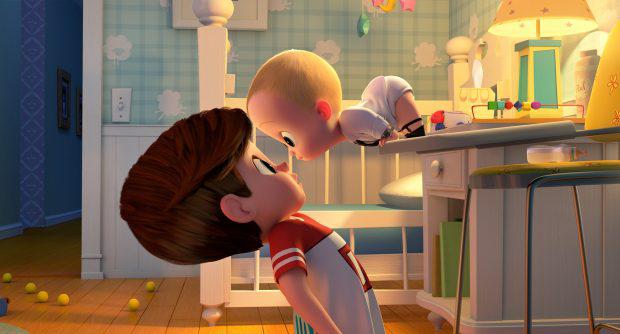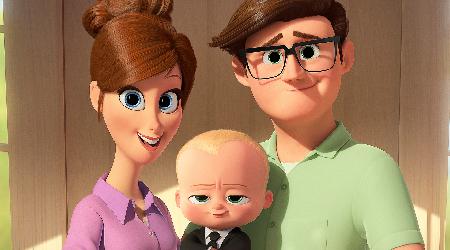An Interview with The Boss Baby Director Tom McGrath
With a career starting as an animator on Ralph Bakshi’s Cool Word and The Ren and Stimpy Show Tom McGrath now finds himself the director of DreamWorks latest hit The Boss Baby. The feature film see’s Alec Baldwin’s imperious infant on a secret quest to reclaim the cuteness crown away from puppies, the Boss Baby is hindered in his efforts by his older adopted brother Timothy (played by Ralph Bakshi’s Grandson Miles Bakshi).

McGrath’s work as an animator, writer, storyboard artist, director and even voice over artist has kept his name consistently on the credits of many movies and since 2005 he has found a home at DreamWorks directing the Madagascar features Megamind and now The Boss Baby. We caught up with him to ask him a few questions about his career and his approach to filmmaking.
How has directing this feature been influenced by your early career working on Space Jam and working on Ren and Stimpy?
I think that’s a cool question because that I don’t get that very often which is great. When I started animation Fiona it was 1986. I had the fortune of being at Cal Arts. My teachers were the old animators at Disney, Frank, Ollie and Glen Keane. I went with the animation because I loved it growing up as a kid. I loved the animating, it was all hand drawn, traditionally 2D. Space Jam was great because I got to animate the Warner Brothers and it was very squash, stretch and cartoony.
Tom McGrath
As we got into like say the Madagascar and CG animation and that type of thing, it was always aspiring to do all the thing we could do so easily with hands drawn animation. I just started to notice along the way that we were getting very realistic in our worlds and how we animated our characters. For Boss Baby it just felt like you know this is a great opportunity to go back to what many of us, including myself loved about animation from the first golden days, the 40’s, 50’s and 60’s. Now that computers can do anything you want it to do or we could do when we use to hand paint everything and give it that look and feel and that charm of like stepping into a painting, which is more magical experience. So we designed our characters and our rigs so they could we could do all the things, we only used to be able to do when we hand drew it. And we wanted our all back-drops and backgrounds to feel like they were painted rather than photographed.
One of my favourite parts of the movie was imagination scenes and how colourful and vivid they are.. Is this how your background inspired this stylistic choice? And what encouraged you to only have this in segments rather than making the whole thing that style?
I’d love to do the whole thing like that you know it’s baby steps. I worked on Madagascar 3 we did one sequence where it was a circus act which was very much inspired by pink elephants on parade. We got to do something very stylized it started to bring back thoughts like, wow we can do this with the computer now. I’d love to do more of that. Boss Baby since we’re portraying a kid’s imagination, we could do a lot more then and from the inception of the movie we knew we wanted to do these really heightened, stylized and fancy moments with the kid and we wanted to differentiate them in the movie to the rest of the story. It became a story point that Boss Baby had been growing up in business head and has not had a childhood and it becomes something that the kids will give him. But to do that, we were very much inspired by some of our heroes of animation. Mary Blair, Maurice Noble and Eyvind Earle all these artists of the last century. And to do that we needed to make our own pipeline to develop the sequences, so as a team of five people making shorts within a movie. It was tricky to pull off, because when you do something that graphic and that stylized you also had to do in 3D. So we had to use new tools and invent new technologies that can enable us to use that graphic art in a 3D environment.
Do you have a favourite scene in the movie?
My favourite scene, well there’s a few of them. I love the imagination sequences. I love the beginning where Boss Baby’s introduced and we find out how he gets selected for management, because to me that sets the tone of the movie. Which harkens back to the movies of our childhood, when they weren’t so aggressive and they actually had a bit of charm for their time. But really it started with the script, we knew what we wanted it to end on. So that last scene is just music with Hans Zimmer, no dialogue and it’s just visual to tell the story. The challenge was to then back engineer the characters story so we could make that end scene feel earned and pay off.
So with the last scene with Hans Zimmer, did you animate to the score?
He was inspired by this piece of music by Howard Hansen, Romantic Number two, I think. Sometimes if you listen to music and it evokes imagery. So what Hans says he creates all these themes, he created one for Tim he created one for Boss Baby. And he created a theme for love, actually, which was a combination of those two themes, his work is pretty detailed and how you string together these themes can make an emotional theme pay off. He with holds instrumentation throughout and then has the orchestra end off. It was really a great experience and we recorded this scene even orchestra was moved by it because it’s rare we get to play that old school hollywood score. And people actually fill up with tears if not even seeing the scene in the movie because the music evokes so much emotion. So Hans Zimmer is always the secret ingredient of not being manipulative but underscoring a story. Here’s our cause for this story that it has been critiqued quite a bit.

The Boss Baby (Alec Baldwin) infiltrates the family, including Mom (Lisa Kudrow) and Dad (Jimmy Kimmel)
And I was just wondering what was the clincher in you picking up this story and running with it and making it. Technically better than the story line is with this incredible animation and using hands in there.
Well to me the story is a bit personal for me it was personal for a lot of people that came on the movie, I had lived the sibling rivalry story with my brother. And it felt like as much as it is a comedy there is a message to this movie about love and about family. And that was always the spine we hung the comedy on. Now with this in mind, we didn’t want the movie to be a string of gags, we wanted to say something about families, love, brothers and sisters. The emotional core I think was in the DNA of our storytelling. That’s why the ending was probably the most important thing to me. Because that’s where their character relationship really pays off.
The success of the story for me personally was enhanced by certain additional traits and gimmicks. One of which was the character Wizzy, Tim’s comedy alarm clock.
Can you tell us more about the role he played and his journey and development in the film?
Well the story is really interesting with our process, when we when we make the movie. Wizzy wasn’t in the original script. And it came out of an idea from a story artist who thought Tim should have an alarm clock. So, Wizzy really started as a drawing and like oh if that kid only has one friend in the world, maybe it’s his alarm clock. So my nephew gave a good impersonation and he gave a voice to that clock and then we started writing more Wizzy moments. What’s great about animation, is as part of our process it’s like workshopping a play. So I think that you can explore them and create a bigger part for them, and it’s not like live action movies where you have to stick to the script and shoot. You know Wizzy is a testament to how we can be changing and improving our story.
What advice do you have for recent graduates and students trying to break into this industry?
I think animation is bursting you know when I started in 1986, there wasn’t much going on at all. In fact it wasn’t until Roger Rabbit came out did it have this resurgence. Followed by The Little Mermaid. Now it seems like you know there are so many opportunities for students to get into animation whether it’s the video game industry or VR. For me I just had a passion for it and no matter what people said, how hard it was to get into the industry, you never give up. And everyone I know that has a passion for it and has never given op has done something in the industry. Now more than ever it’s important to express your own voice because all animated movies are starting to look the same, starting to feel the same. I think the other thing is to just embrace their own style and their own personal story because then the richer the animation is going to be. So now it’s all about original stories and original looks so they don’t all turn into one long movie.
Very quickly on the back of that you’re talking about all animated films turning into a similar style so what is your favourite animated film?
That’s a good question. You know my favourite animated film isn’t an animated film (chuckles), I remember when I was a kid and the Pink Panther movies in particular had these great animated opening titles. I actually remember watching Peter Sellers. He was so animated and so funny as a kid I would just laugh at him. My parents would laugh at some of the jokes that went over my head. But I remember as a family we could watch these movies together even though I didn’t understand some of the double entendres in there. And it was that shared movie experience that proliferates what we’re trying to do with Boss Baby.
The Boss Baby is playing in UK cinemas now.



